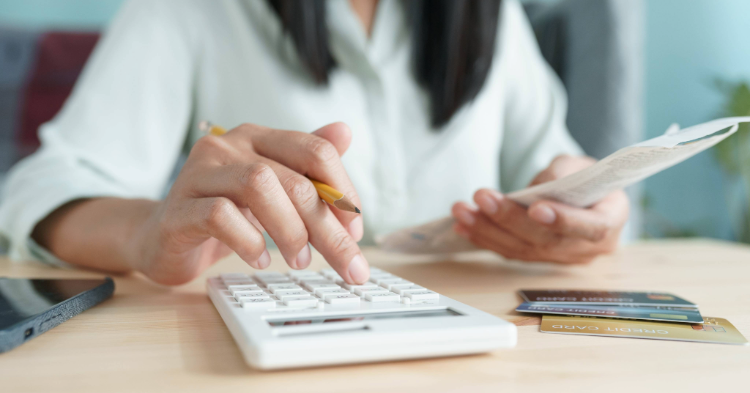Having credit card debt can feel overwhelming, but it can be paid off with the right approach and effort. Whether you’re dealing with a high balance on one card or juggling payments on multiple accounts, the right plan can help you move forward. With consistent focus and smart strategies, you can get out of debt and regain control of your financial future. Let’s walk through some actionable steps and popular strategies that can help you pay off credit card debt and protect your credit score along the way.
Six steps to pay off credit card debt.
1. Review your budget.
Start by understanding your income and monthly expenses. Identify how much money you can realistically put toward your credit card payments. A clear view of your finances can help you prioritize debt repayment without neglecting essentials like rent, utilities or groceries.
2. Cut expenses.
Look for opportunities to stop spending money. This might mean canceling subscriptions, cooking at home more often, or finding free alternatives for entertainment. Every dollar saved is a dollar that can go toward reducing your outstanding balance.
3. Earn more.
If possible, consider picking up a side hustle, selling unused items or asking for extra hours at work. Increasing your income, even temporarily, can help you make larger monthly payments and pay off credit card debt faster.
4. Make a repayment plan.
Choose a strategy that fits your financial situation. Whether it’s paying off the highest interest rate first or focusing on the smallest balance, having a plan can keep you motivated and focused.
5. Contact your credit card company.
Your lender may be willing to work with you. Some credit card companies offer hardship programs or can temporarily reduce your interest rate. It never hurts to ask.
6. Celebrate progress.
Paying off debt takes time, so celebrate the milestones. Every payment you make helps reduce interest charges and brings you closer to being debt-free.
What are the best debt repayment strategies?
The right debt repayment strategy can make a big difference in how quickly and affordably you become debt-free. Each method has its own strengths and can be tailored to different financial situations.
Debt snowball method
The debt snowball method is popular for its psychological momentum. Here’s how it works:
Step 1: List your credit card debts from smallest to largest balance.
Step 2: Make minimum payments on all accounts except the one with the lowest balance.
Step 3: Focus any extra funds on the smallest balance until it’s paid off.
Step 4: Once that card is paid off, roll its monthly payment into the next smallest debt.
This approach doesn’t necessarily save the most on interest, but many people find the quick wins motivating. Seeing debts disappear, even small ones, can keep you engaged and determined.
Debt avalanche method
The avalanche method takes a more math-focused approach:
Step 1: List all of your credit card debts by interest rate, from highest to lowest.
Step 2: Make minimum payments on all of your cards, but focus extra payments on the card with the highest interest rate.
Step 3: Once that card is paid off, shift your focus to the next highest rate.
This strategy helps you pay less in interest overall and may get you out of debt faster. If your highest-interest card has a large balance, it might take longer to see progress, but it’s typically more efficient than the snowball method.
Debt consolidation
Debt consolidation means combining multiple credit card balances into one new balance, ideally with a lower interest rate. This can simplify your monthly payments and reduce interest charges over time. There are a few common ways to consolidate credit card debt:
Personal loan. A personal loan provides you with a lump sum of money from a lender that you use to pay off all your credit card balances. Look for a loan that offers a low, fixed rate so you can repay the personal loan with predictable weekly, bi-weekly or monthly payments. This option can often provide you with a lower interest rate than your credit cards, saving you money over time.
Balance transfer credit card. Many credit cards offer a 0% introductory annual percentage rate (APR) for a set period of time, usually 12 to 18 months. Transferring your existing credit card debt to a new card with a lower interest rate can give you more time to pay down or pay off your existing debt, interest-free. Just keep in mind the balance transfer fee, which is typically 3% to 5% of the amount transferred. And try to avoid making any new purchases on a balance transfer card.
Home equity loan or line of credit. If you own a home, you may qualify for a home equity loan or a home equity line of credit (HELOC). These types of loans can come with a lower fixed or variable interest rate. These are secured by your home, so there is risk involved if you can’t repay.
All of the debt consolidation options above come with pros and cons, and eligibility will depend on your credit score, income and other factors. Be sure to compare offers and read the fine print before committing.
Debt management plan
Working with a credit counseling agency can help you create a debt management plan (DMP). This plan rolls multiple credit card debts into one monthly payment, often with reduced interest rates and waived fees. The agency negotiates with your credit card companies on your behalf.
You’ll typically make a single monthly payment to the agency, which then distributes the funds to your creditors. DMPs usually last three to five years and require that you close your credit card accounts while in the program.
Debt settlement
Debt settlement involves negotiating with your credit card company or lender to accept less than the full amount owed. This approach can have serious consequences, including negative effects on your credit score, late fees, and potential tax implications. It’s generally considered a last resort for borrowers in severe financial distress.
If you’re considering debt settlement, it’s important to work with a reputable provider and understand all potential outcomes.
How does credit card debt affect my credit score?
Carrying large credit card balances can impact your credit utilization ratio — a major factor in your credit score. The more you owe compared to your credit limit, the more your score could be affected. Making at least your minimum payment on time can help protect your credit history and avoid late fees.
Missed payments, maxed-out cards, and a high total balance can all drag your credit score down. On the flip side, reducing your outstanding balance and making consistent monthly payments can gradually improve your score over time.
What is the 15/3 rule?
The 15/3 rule is a money management tactic that involves making two payments each month: one 15 days before your statement due date, and another three days before. The goal is to reduce your credit card balance before your statement closes, which can lower your reported utilization and potentially improve your credit score.
This technique is particularly helpful if you frequently use your credit card and want to keep your utilization below 30%.
How long does it take to pay off credit card debt?
It depends on your total balance, interest rate, and monthly payment. If you only make the minimum payment, it could take years. But increasing your monthly payment—even by a small amount—can significantly shorten the payoff period and reduce interest charges.
For example, let’s say you have $5,000 in credit card debt at an interest rate of 20%, and you make a monthly payment of $150. It could take over four years to pay off, and you’d pay thousands in interest. But increasing your monthly payment to $250 could help you become debt-free in just over two years and save hundreds in interest.
Online debt payoff calculators can help you estimate your timeline based on different payment scenarios.
The Bottom Line
Paying off credit card debt won’t happen overnight, but it is possible. With a realistic budget, a smart repayment strategy and some perseverance, you can move closer to a debt-free future. Consider options like balance transfers, personal loans or credit counseling if you need extra support.
And remember, every step you take is a step toward better financial health. Whether you’re just starting out or almost there, keep going — your future self will thank you.
DISCLAIMER: This content is for informational purposes only and should not be considered financial, investment, tax or legal advice.






